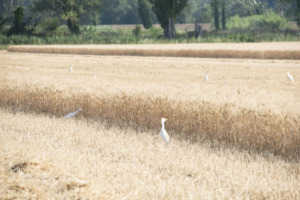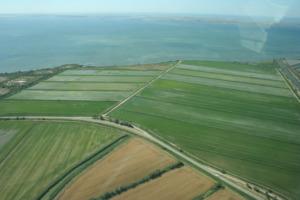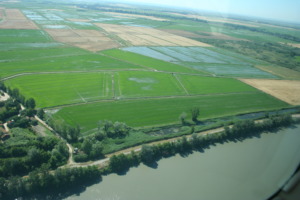Project objective
Occupying one third of the earth’s total land area, and over half in France, farming activities support biodiversity but are sources of pressure on it. A significant proportion of wetland species now depend on agricultural environments to complete their life cycles. Conversely, many ‘agricultural species’ such as insectivorous birds find additional food resources in wetlands.
The aim of our project is to study how agricultural practices and landscapes can better participate in hosting and restoring biodiversity in Mediterranean wetlands. In the Camargue, we will be focusing on arable land and pasture land, as well as arboriculture, viticulture, and market gardening, which are more marginal in terms of total land area, but represent the diversity of the Camargue landscape.

We decided to focus on three priority taxa: birds, chiroptera, and dragonflies. These taxa have not only a high heritage value, but also a key potential as crop auxiliaries.
The main threats addressed in this project are the decrease in the quality of agricultural habitat for biodiversity due to landscape simplification (e.g., disappearance of hedgerows), pollution by pesticides and inputs, unfavourable water management, misuse of veterinary drugs (e.g., ivermectin toxic to coprophagous insects), and climate change (salinisation, drought). We will study the effects of nature-based solutions such as hedge planting and nest boxes, as well as the effects of changes in practices (organic farming, conservation farming), and we will promote solutions that help to maintain the biodiversity emblematic of this area.
Actions & methodology
At the Tour du Valat Estate (including the Petit Saint-Jean Estate [1]), we are experimenting with agroecological and agroforestry practices aimed at reconciling nature protection and agricultural production.
In the Camargue, we are collaborating with a network of farmers to study how bird, odonata, and chiroptera communities vary along a gradient of agro-ecological infrastructure (i.e., from completely open fields to small, hedged fields). This area of research is the subject of Pierre Mallet’s Ph.D. thesis (2019-2022) co-supervised by INRAE Toulouse (Dynafor).
In the Camargue, we also wish to develop an integrated model of activity networks, ecosystem services, and biodiversity. This area of research is the subject of a Ph.D. thesis (2022-2025) co-supervised by INRAE Colmar. This thesis will focus on better understanding how farming practices can contribute to maintaining the hydrosaline balance of the Camargue.

Our work also seeks solutions to conflicts between biodiversity and agriculture, by studying and experimenting with approaches that would, for example, reduce the damage caused to crops by Greater Flamingos or Common Cranes.
Finally, in the Mediterranean, we are part of the Alliance for Mediterranean Nature & Culture [2] in an effort to strengthen the visibility of cultural landscapes among decision-makers and to share knowledge and know-how common to traditional agriculture. We will also seek to transfer our experience on the links between biodiversity and agriculture to other wetlands in the Mediterranean Basin.
Findings
Our initial findings on agroecological infrastructure show that:
- AEI (agroecological infrastructure) at the edge of fields or in the agricultural landscape is beneficial to biodiversity, but with differences in function of the taxa. More precisely, we have observed that:
– Hedgerows are beneficial to forest edge birds
– Reeds growing in irrigation and drainage channels are beneficial to marsh birds
– Uncultivated grass strips are beneficial to spiders
- Some species are disadvantaged by certain types of AEI. For example, grassland birds or marsh birds do not appreciate the presence of hedgerows. This finding confirms other studies on the importance of adapting AEI restoration efforts to the local context of farming practices and biodiversity. In the Camargue, the largest wetland in France, hedgerow replanting should be planned in a way that is beneficial to certain species (for example, auxiliary species such as bats and insectivorous birds) but does not harm wetland species.
See the article : Mallet P., Béchet A., Galewski T., Mesléard F., Hilaire S., Lefebvre G., Poulin B., Sirami C. 2022. Different components of landscape complexity are necessary to preserve multiple taxonomic groups in intensively-managed rice paddy landscapes. Agriculture, Ecosystems & Environment 328:107864. doi: 10.1016/j.agee.2022.107864 [3]
Team
- Project leader : Arnaud Béchet [4], Thomas Galewski [5]
- Members : Damien Cohez [6], Nicolas Beck [7], Thomas Blanchon [8], Samuel Hilaire [9], Olivier Boutron [10], Lisa Ernoul [11], Hugo Fontes [12]
- Project date : since 2019
Partners
Technical partners
- Dynamique des paysages agriforestiers (Dynafor [13])
- Laboratoire Agronomie et Environnement (INRAE Colmar)
- Parc naturel régional de Camargue [14]
- Centre Français du Riz [15]
- Cirad
- Groupe Chiroptères de Provence
Financial Partners
- Alpina-Savoie [16]
- Fondation de France [17]
- Biosud [18]
- Fondation Léa Nature [19]
- Fondation Albert II
